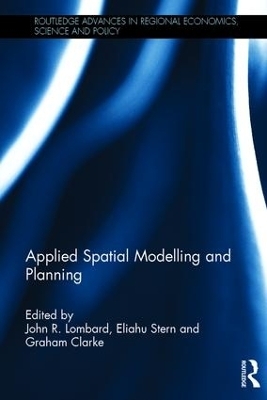
Applied Spatial Modelling and Planning
Routledge (Verlag)
978-1-138-92570-0 (ISBN)
Applied Spatial Modelling and Planning shows how much geographical research is policy relevant to a wide variety of agencies through the use of GIS and spatial modelling in applied geography. The book’s chapters contain a cross-section of innovative applications and approaches to problem solving within five major domains of the dynamics of economic space, housing and settlements, population movements and population ageing, health care, and the environment. Using a number of case studies on the use of GIS and spatial modelling, this book demonstrates the fact that much of what is done by quantitative geographers is not only relevant within academia, but also has use in policy work.
This book will appeal to an international audience interested in cutting-edge spatial modelling to better understand the processes involved in solving real problems.
John R. Lombard is an Associate Professor in the School of Public Service at Old Dominion University, USA. Eliahu Stern is Professor of Geography and Planning at Ben-Gurion University of the Negev, Beer Sheva, Israel. Graham Clarke is Professor of Business Geography at the University of Leeds, UK.
Chapter 1: Introduction John Lombard, Eli Stern and Graham Clarke
Chapter 2: Applied spatial modelling: ‘big science’ and ‘best practice’ challenges Sir Alan Wilson
Part I Dynamics of economic space
Chapter 3: An exploratory analysis of new firm formation in New England Jitendra Parajuli and Kingsley E. Haynes
Chapter 4: The impacts of policy changes on overseas human captial in Australia: the implementation of the 485 graduate visa Jonathan Corcoran, Francisco Rowe, Alessandra Faggian, and Robert Stimson
Chapter 5: On the three ‘laws’ of spatial interaction and a string theory finale: perspectives from social physics with examples in the digital and retail economy Robert G.V. Baker
Part II Housing and settlements
Chapter 6: Spatial typology of the private rental housing market at neighbourhood scale: the case of South East Queensland, Australia Yan Liu, David Wadley and Jonathan Corcoran
Chapter 7: Optimal kernel and bandwidth specifications for geographically weighted regression: an evaluation using automated valuation models (AVMS) for mass real estate appraisal Paul E. Bidanset and John R. Lombard
Chapter 8: Spatial search: new settlements for Israel's ultra-orthodox population Eliahu Stern
Chapter 9: A tale of two earthquakes: dynamic agent-based simulation of urban resilience A. Yair Grinberger and Daniel Felsenstein
Part III Population dynamics and population ageing
Chapter 10: The United Kingdom’s multi-ethnic future: how fast is it arriving? Philip Rees, Pia Wohland and Paul Norman
Chapter 11: Decomposition of life expectancy at older ages and prospects for ageing populations Leslie Mayhew and David Smith
Chapter 12: Using agent-based modelling to understand crime phenomena Nick Addis
Part IV Health care planning and analysis
Chapter 13: Modelling the impact of new community hospitals on access to health care Holly Shulman, Graham Clarke and Mark Birkin
Chapter 14: SimSALUD – towards a health decision support system for regional planning Melanie N. Tomintz and Victor M. Garcia-Barrios
Chapter 15: Small-scale agent-based modelling of infectious disease transmission: an example in a primary school Mike Bithell
Chapter 16: Exploring small-area geographies of obesity in the UK: evidence from the UK Women’s Cohort Study Michelle A. Morris, Graham Clarke, Kimberley L. Edwards, Claire Hulme and Janet E. Cade
Chapter 17: Examining the socio-spatial determinants of depression in the UK Karyn Morrissey, Peter Kinderman, Eleanor Pontin, Sara Tai and Matthias Schwannauer
Part V Environmental modelling
Chapter 18: A case study of flooding in the Limpopo River Basin, Xai-Xai, Mozambique Robert Fligg and Joana Barros
Chapter 19: A computational framework for mitigating land degradation: a synergy of knowledge from physical geography and geoinformatics Tal Svoray
| Erscheint lt. Verlag | 8.9.2016 |
|---|---|
| Reihe/Serie | Routledge Advances in Regional Economics, Science and Policy |
| Zusatzinfo | 68 Tables, black and white; 74 Line drawings, black and white; 24 Halftones, black and white; 98 Illustrations, black and white |
| Verlagsort | London |
| Sprache | englisch |
| Maße | 156 x 234 mm |
| Gewicht | 725 g |
| Themenwelt | Naturwissenschaften ► Geowissenschaften ► Geografie / Kartografie |
| Sozialwissenschaften ► Soziologie ► Spezielle Soziologien | |
| Wirtschaft | |
| ISBN-10 | 1-138-92570-5 / 1138925705 |
| ISBN-13 | 978-1-138-92570-0 / 9781138925700 |
| Zustand | Neuware |
| Haben Sie eine Frage zum Produkt? |
aus dem Bereich


